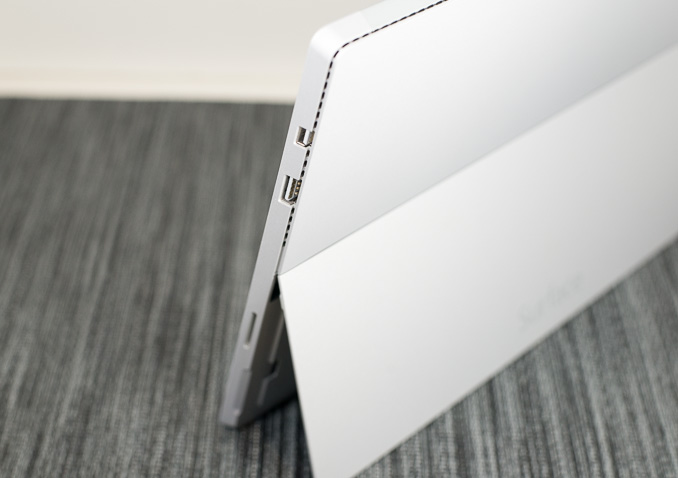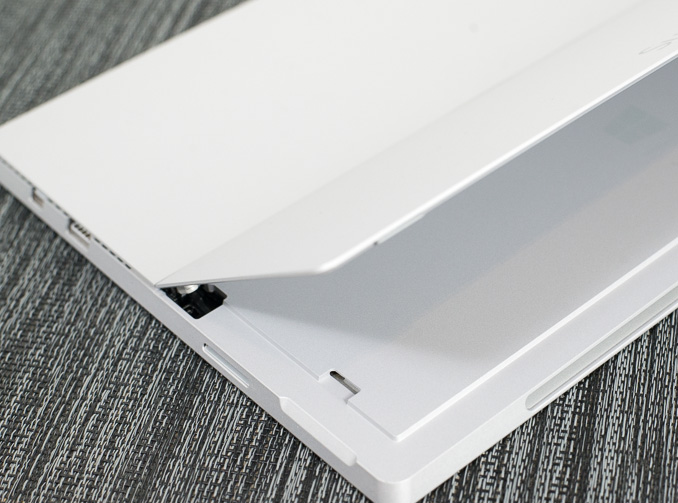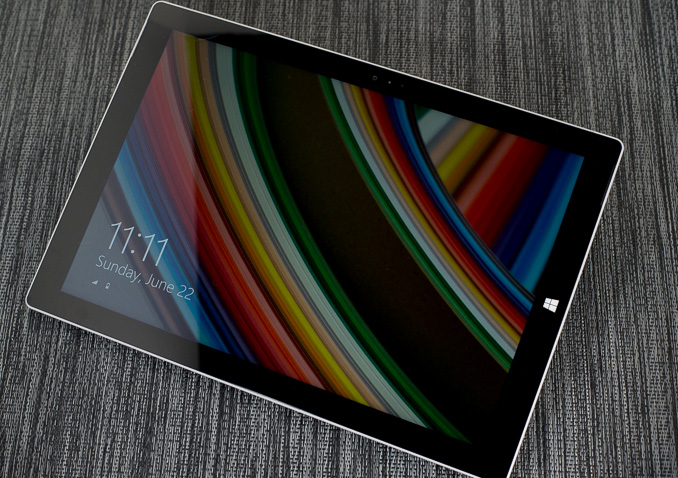Microsoft Surface Pro 3 Review
by Anand Lal Shimpi on June 23, 2014 3:55 AM ESTFinal Words
When I reviewed the first Surface Pro I was intrigued by the idea, but felt it needed a few more iterations to get to the right point. In less than two years what we have in front of us looks very different than Microsoft's original vision for the platform. Display size, aspect ratio and even the mechanics of the whole thing are all quite different. The changes are for the better as Surface Pro 3 is a much better laptop and a much better tablet than any of its predecessors. The device no longer feels cramped and tiring to use as a laptop. The new Surface Pro no longer feels heavy to use as a tablet either. It's truly an improvement on both vectors.
Microsoft might be overselling the design to say that it truly is the only device you need. Like most compromises, Surface Pro 3 isn't the world's best laptop nor is it the world's best tablet. It serves a user who wants a little of column A and a little of column B.
The device's "lapability" is tremendously better than any of its predecessors. While I wrote all of the previous Surface reviews on the very Surface devices I was reviewing, this is by far the most comfortable one to use as a laptop. It's still not perfect, and you still need a fairly long lap to make it work, but the design is finally really usable as a laptop.
As a tablet the thinner and lighter chassis is much appreciated. The new kickstand remains one of the best parts of the design, enabling a flexibility unmatched by any other tablet. Tent mode in particular is awesome for tablet usage models.
Surprisingly enough the move away from Wacom to an active NTrig pen model comes with very few issues. The device could use some tuning of its pen pressure curves. Applying max pressure on the screen now distorts the LCD, something I'm never comfortable doing. But overall the new pen gives up very little and even improves performance and functionality.
The new Type Cover is awesome. The keyboard is probably as good as it's going to get, and the new trackpad is finally usable. The latter isn't perfect but it's so much better than anything that's come before it.
The device also launches with a far more polished version of Windows. With its latest updates, Windows 8.1 is a far cry from where it first started. I still think there's lots of room for improvement, but it's clear that Microsoft is marching towards a more cohesive vision of modern and desktop Windows UIs.
The downsides for Surface Pro 3 are obvious. Windows 8.1 remains a better desktop/notebook OS than a tablet OS. Yet in a device like Surface Pro 3 where you're forced to rely on touch more thanks to a cramped trackpad, I'm often in a situation where I'm interacting with the Windows desktop using the touchscreen - a situation that rarely ends well. As Microsoft improves the behavior of its modern UI apps, I would love to see a rethinking of what touch looks like on the desktop. If Surface Pro 3 exists to blur the lines between laptop and tablet, Windows 9 needs to do a better job of the same. The desktop needs to react better to touch and the modern apps need to feel even more integrated into the desktop.
On the hardware side, the device is a compromise. You have to be willing to give up some "lapability" in order to get a unified laptop/tablet device. Whether what you get as a tablet is worth the tradeoff is going to be up to how good of a tablet OS Windows 8.1 is for you. Personally I find that Android and iOS deliver better tablet experiences particularly when it comes to 3rd party applications. If everything you need on the tablet front is available in the Windows Store however then the point is moot.
Those users upgrading from Surface Pro 2 may notice a regression in performance, particularly when it comes to running prolonged CPU/GPU intensive workloads. In games, the difference can be noticeable. The simple fact is that in becoming a thinner device, Surface Pro 3 inherited more thermal constraints than its predecessors. While performance regressions aren't ideal, in this case I can appreciate what Microsoft has done. From the very beginning I wanted a lower TDP part in a thinner chassis. Had Microsoft done that from the start we wouldn't have seen any performance regression but rather a steady increase over time. From my perspective, Surface Pro 3 is simply arriving at the right balance of thermals and performance - the previous designs aimed too high on the performance curve and required an unreasonably large chassis as a result.
The remaining nitpicks are the same as last time: Microsoft needs to embrace Thunderbolt, and a Type Cover should come with the device. The display's color accuracy is good but grayscale performance needs some work.
Surface Pro 3 is easily the best design Microsoft has put forward. If you were intrigued by the previous designs, this is the first one that should really tempt you over. I was a fan of the original Surface Pro, and with Surface Pro 3 I think Microsoft has taken the hardware much closer to perfection. At this point the design needs more help on the software side than hardware, which is saying a lot for the Surface Pro hardware team. Personally I'd still rather carry a good notebook and a lightweight tablet, but if you are looking for a single device this is literally the only thing on the market that's worth considering. I don't know how big the professional productivity tablet market is, but it's a space that Microsoft seems to have almost exclusive reign over with its Surface line. With its latest iteration, Microsoft is serving that market better than ever.













274 Comments
View All Comments
Walkop - Wednesday, September 17, 2014 - link
Edit: never , I see you meant now.Walkop - Wednesday, September 17, 2014 - link
Stupid Chrome Beta and gesture keyboards… *never mind, *see whatWalkop - Wednesday, September 17, 2014 - link
No.The Surface Pro's aspect ratio gives it a bigger display area than both MacBook Air's.
Sabresiberian - Monday, June 23, 2014 - link
I don't understand why you need a comparison written as an article. You are certainly capable of doing it for yourself - and have. :)Tegeril - Monday, June 23, 2014 - link
"TypeCover=1095g" when Macbook Air 11 is 108x grams but represented in kg suggests some sort of odd agenda, if you ask me.drmyfore - Tuesday, June 24, 2014 - link
Surface Pro 3 / 7.6V 42.2Whr 5547mAhMacbook Air 11 / 7.6V 38.75Whr 5100mAh
Macbook Air 13 / 7.6V 54.4Whr 7150mAh
Obviously, in battery life test, the MBA 11 is more appropriate than MBA 13.
name99 - Tuesday, June 24, 2014 - link
I think the more interesting comparison is with iPad Air.Basically (depending on the details) it's 2 to 3x as fast, with 3x tending to kick in when hyper threading is useful. How long does that advantage last?
The speed bump from A5 to Swift was about 2x, split between about 1.6x frequency improvement and 1.2x µarchitecture improvement. This accompanied a 45 to 32nm process change.
Swift to Cyclone was about a 1.5x improvement, all in architecture and µarchitecture, with a minor process improvement (32nm to 28nm HK).
A8 is expected to be a substantial process improvement (20nm, but still not FinFet). Personally I think this round the big changes will be in an Apple branded graphics cell and in the uncore, with minor changes in the core, but from process we should expect about a 1.5x boost, with obvious frequencies being 1.8 or 2GHz. So with the A8 round Apple does not hit Haswell, but gets a lot closer. Of course we then get Broadwell, but we expect Broadwell to be what, a 1.1x speedup or so?
IF Apple decides this is the year to switch to three cores rather than 2 that gives us a further factor of 1.5x (for that fraction of benchmarks that are substantially parallel) and we get even closer.
I'm on the fence about whether this makes sense yet, but Apple tends to design for products that stay relevant for 4yrs or so; and if they believe they're going to achieve substantially more parallelism over the next 4 yrs, it may make sense to do this now. They may also feel the marketing pressure is becoming problematic given the supposed China love of extra cores. They may also, this round, give us an A8X variant for iPads with three cores, keeping the phone A8 at two cores?
One final point is that, as Apple has methodically reached into the standard bag of "how to improve your CPU" tricks, one trick they have not yet used is that of putting a very small PMC on die to control turbo-ing --- like all ARM they're still doing everything in SW.
It seems obvious that at some point this will change, and the A8 may be the SoC where it changes. Ultimately such a change will allow Apple to get closer to Intel simply because it will be able to do the same sort of short high-speed thermally limited sprints that Intel can do. Of course it took Intel quite some time to get from the first generation of PMCs to today's sophisticated monsters that take into account things like thermal inertia, so one should expect that Apple's first attempt will not be nearly as aggressive as Intel --- though by the third attempt ...
Narg - Wednesday, July 30, 2014 - link
Why compare it to a Mac at all??? Most consumers won't bother with this, either they want Mac or they don't. It'd be better to compare it to say a Dell or Lenovo ultra/tablet/mix/something.coolhardware - Tuesday, June 24, 2014 - link
Interesting how few devices have a 3:2 aspect ratio, I notice the Nook HD+ as one and of course the Surface Pro 3 as another:http://pixensity.com/list/tablet/
I had the Nook HD+ and it is a very nice ratio IMHO (not too wide, not too tall).
I more Android tablets would start going 3:2 or 4:3 as I find it to be very beneficial for productivity work.
PS for movie viewing the ratio is not ideal, but in those cases I often just zoom in to fill the entire screen.
mmrezaie - Monday, June 23, 2014 - link
I tested it couple of times but I cannot get around the fact that this is still a beta, and they are asking too much for the price. I would rather go for thinkpad X or macbook air. Touch on Win8 is still a joke, and no homogeneity in software side.